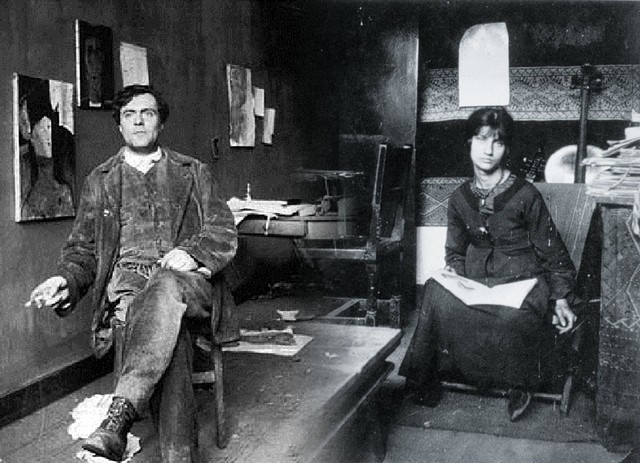




BY GIANCARLO GRAZIANI | Ce.St.Art. – Center for Studies of Art Economy
The death of Amedeo Modigliani and of his devoted partner Jeanne Hebuterne starts one of the most emblematic stories of the Art Market, which will lead the works of the unfortunate Tuscan artist to be subject of an “exceptional enterprise of economic revaluation”. The acme of the speculative operation has been reached with the auction award for 170,405,000 US dollars of the “Red Nude”, which previously belonged to Gualino Collection and to Feroldi Collection and then in 1950 was acquired by the art collector Gianni Mattioli thanks to the interest of his cousin, Fernanda Wittgens, the then Director of the Pinacoteca di Brera.
The valorization of Modigliani’s Work thus began in the ‘50s on both sides of the Atlantic Ocean: in Europe activities revolved around “Il Milione Gallery” in Milan and in America around MoMa – Museum of Modern Art in New York (the same museum that was subject of a conceptual work by the German artist Hans Haacke in 1970, who emphasized the connection between the museum and the economy and politics).
Although Modigliani’s paintings, sculptures and drawings had already been exhibited in 1922 in Paris, in 1930 in Venice, in 1933 in Brussels and in 1934 in Basel, their economic value did not grow sufficiently (Leopold Zborowski died in misery in 1932, despite the quantity of Modigliani works he had put on the market) ; so much that his works were suitable to a clever speculative operation based on the fact that the signature style of the artist was easily recognizable by many and therefore with a “certain ease” it was possible to turn “Modì, the maudit” into a “status symbol” such that many will want it because everyone will know who he is, a basic concept of marketing.
Until then the works of the artist from Livorno were made object of attention by collectors for sure wealthy but certainly far from multimillionaires and then billionaires assets necessary to acquire these painting in later years.
In the Kingdom of Italy – which in 1941 presented under its patronage in Cortina d’Ampezzo an exhibition with more than 500 artworks from the most important Italian private collections of modern art –, the nautical engineer Alberto Della Ragione owned 5 Modigliani paintings and the textile industrialist Riccardo Gualino owned 7 paintings, including the “Self Portrait” stored at the MASP – Museu de Arte de São Paulo; in 1946 the gallerist Pietro Maria Bardi brought to Brazil the 3 Modigliani paintings now stored at the MASP, of which he will be Director, and also the other paintings he will sell to Francesco Matarazzo for his MAM – Museum of Modern Art in the Paulista capital.
To further understand how Modigliani was considered on the market in 1942, it is interesting to report what the Italian painter Luigi Corbellini, exponent of the Ecole Italienne de Paris, wrote to his friend and patron Carlo Anguissola di Travo in a letter dated September, 19th 1942: “I found four magnificent Boldini paintings and by contrast I bought four beautiful Amedeo Modigliani paintings. I know that this kind of painting shocks you a little bit, but I believe in this painting, which has brought a bit of madness to some too wise painting. Can you tell me what press reviews Modì currently has? Here his paintings are highly sought after and can no longer be found; I think one day he will have the great place he deserves in Italy too. It is true that we are never prophets in our country, with a few exceptions”.
In 1934 a “Portrait of a man” was sold in New York for 1,200 US dollars and in 1946 a “Portrait of a woman” was purchased for 3,300 US dollars, a figure that represented the average price of the period: Modigliani was not a big deal at that time and therefore he did not even attract counterfeiting, but represented a potential business for sharp investors.
The “enterprise” thus began to produce exhibitions and catalogues: the first catalogue, in 1929, was published by Arthur Pfannstiel – defined “his biographer” by Ludwig Meidner, friend of Modigliani, in the book “The Young Modigliani” written in 1943 – with the introduction by Louis Latourettes, a rich art lover and also friend of Modigliani: but this catalogue was only a study for art lovers and academics (Pfannstiel will then publish two updated editions in 1954 and 1956).
It began from the richest side of the Atlantic Ocean, the United States, with the exhibition in 1951 at Museum of Modern Art in New York and at Museum of Modern Art in Cleveland (where Corbellini “Hernry Laurens” was also exhibited), in 1955 at Art Institute of Chicago, in 1959 at Fogg Art Museum of Harvard University in Cambridge and at Contemporary Art Center of the Art Museum of Cincinnati ; then it moved to the European side, with the exhibition in 1958 in Milan at Palazzo Reale, in Paris at Charpentier Gallery, in Marseille at Musee Cantini and in 1959 in Rome at National Gallery of Modern Art, crossing again the ocean in 1961 with the exhibition at the Museum of Fine Arts in Boston; finally the “tour de force” terminated , after another ocean crossing, in 1963 in Frankfurt at Kunstverein Museum, in London at Tate Gallery, in Edinburgh at Scottish National Gallery: 13 exhibitions in twelve years in the most important cities in the world with an impressive frequency but certainly not motivated by scientific needs.
All this had to be completed with a repertoire that presented the “original production of Amedeo Modigliani” : this repertoire was taken care of by the art collector Gino Mattioli and “Il Milione Gallery” of Ghiringhelli brothers who financed the catalogue written by Ambrogio Ceroni, appraiser of auction house and collaborator of Franco Russoli – curator of the 1958 exhibition in Milan and true connoisseur of the artist’s work, who worked with Fernanda Wittgens, succeeding her then in the management of Pinacoteca di Brera (the same Franco Russoli, once he became Superintendent of Fine Arts of Milan, in 1973 declared not exportable 26 paintings of the Mattioli Collection , including one painting by Modigliani, and declared “indivisible” the core group which was then loaned to Guggenheim Collection in Venice from 1997 to 2016).
After acquiring the Pietro Feroldi Collection around 1950, between 1952 and 1954 Gianni Mattioli founded the company G&G with Virginio Ghiringhelli for the purchase of artworks and entered into partnership with “Il Milione Gallery” of Ghiringhelli brothers and published in 1958 the first edition of the catalogue on Modigliani by Ambrogio Ceroni, which will then be updated.
Despite the existence of the two other Pfannstiel catalogue editions of 1954 and 1956, the Ceroni catalogue will become the milestone of the market of Modigliani works and only the works published in it , will obtain general acceptance and multimillion-dollar awards and will be auctioned by the best-known auction houses, despite the acknowledged incompleteness and inaccuracy, naturally inherent in any publication that can never be exhaustive and conclusive but only indicative.
At this point of the enterprise, the tools are there and the results of these actions are the following: in 1954 the painting “Raimondo”, belonging to the artist’s Cubist period, was sold for 15,250 US dollars but towards the end of the decade the values doubled to 30,000 US dollars, and on July 6th 1960 Sotheby’s in London sold the “Portrait of a Maiden” for 24,000 British pounds equal to 67,000 US dollars.
Starting from a 100% value base in 1934, the “cursed” Modigliani increased the value to 3,100% in 1960, representing the biggest rise in the ‘50s and this revaluation activity was not finished but had just begun.
In October and November 1960, Sotheby’s sold three Modigliani paintings for 21,000, 22,000 and 38,000 British pounds, respectively equal to 58,000, 61,000 and 106,000 US dollars: the valorization had paid off.
In 1961, however, Jeanne Modigliani, daughter of Amedeo and Jeanne Hebuterne – art historian and holder of the moral right (“droit moral”) of attribution according to French law – wanted to clarify all the father’s work and all the myth, that had been built without bases but that helped marketing, and she wrote the book “Modigliani sans legende” (Editor Gründ, 1961): she was discredited by the market, as always under monopolistic management, and the market also discredited her “Archives Legales Amedeo Modigliani”, founded in 1983 with which she tried to reestablish the truth until the end.
In particular, Jeanne Modigliani wrote that for her father painting was a fallback from sculpture that he could not exercise for reasons of materials costs and for the unavailability of studies of suitable dimensions given their cost ; therefore, he had to practice a lot to reach his results, with an unfinished, sketched, rejected and even destroyed part of production: in the Modigliani literature, eyewitnesses affirm that, he copied his drawings to practice.
So there was no perfect Artist, without mistakes.
Furthemore, Jeanne Modigliani also wrote that “the fundamental elements for an exact and complete reconstruction of the father’s production are missing, given the fragmentary nature of the existing documents due also to the many and poorly documented relocations“.
Therefore, there could be no indisputable repertoire.
And the same happened to Arthur Pfannstiel and to his publications, which are part of every text of the essential bibliography on Modigliani: he was denigrated for the fact that he had operated for Germany, his homeland, during the Second World War and he was denied that, precisely for his role in the inventory of the French Art Collections for the German requisitions, he had gained a great knowledge of the artworks.
But Modigliani was Jewish and therefore could not have a biographer adhering to National Socialism, even if endowed with great competence and knowledge.
To date, the expertises on Modigliani’s works written and signed by Jeanne Modigliani and Arthur Pfannstiel are generally not taken into consideration and the works authenticated by them are not accepted in the sales sessions of the most famous auction houses.
One last note: the “Red Nude”, sold for more than 170 million dollars, was owned by Gianni Mattioli’ heirs at the time of the sale and was not included in the “indivisible core group” of the Mattioli Collection, although already in 1967 Franco Russoli called it “wonderful” and “masterpiece”, and in 1951 Peggy Guggenheim already sat in the board of directors of Museum of Modern Art in New York.
© Giancarlo Graziani, Visiting Professor of Art Economy, Founder member and Supervisor of Ce.St.Art. – Center for Studies of Art Economy
Digital Edition by Salvatore Prato, Member of Ce.St.Art.
Also Read
The Great Spadolini – Dance, Art & Espionage
The World Art News (WAN) is not liable for the content of this publication. All statements and views expressed herein are only an opinion. Act at your own risk. No part of this publication may be reproduced without written permission. © The World Art News
Categories: Artists, Europe, Investigations, Investing, Market, Modern Art, Money, North America, Opinion, Prices























1 reply »